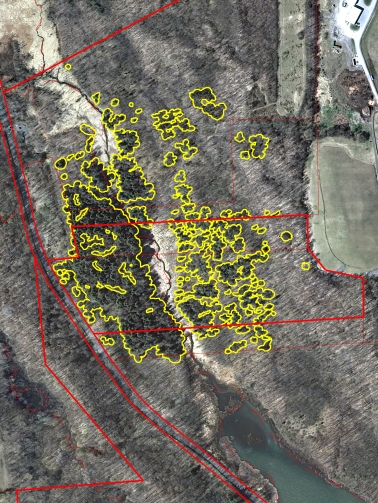 |
| Looking eastward toward the hemlocks across the bog from a spot near the O’loughlan parking lot, January 17, 2015. |
Eastern hemlock (Tsuga canadensis) is present primarily on the old O’loughlin, Fitzgerald, and Pitman-Atkins properties off of Gully Road. But at least as many hemlocks can be found on the private 25-acre Chapman property that sits between the Fitzgerald and Pitman-Atkins properties and the Old Dump on Gully Road. Hemlocks on that property can be found nearly up to the landfill behind the transfer station.
Hemlocks in this area are in danger of infestation by the Hemlock Woolly Adelgid (HWA) Adelges tsugae. Properties along the southern half of Skaneateles Lake have large infestations that threaten to destroy the hemlocks, which are common along both the lake and its tributaries. Aside from the aesthetic loss, this could have serious consequences for the water quality in the lake, which of course is the primary water source for the City of Syracuse.
 |
 |
 |
|
| Hemlock Woolly Adelgid (HWA) infestations at Bahar Nature Preserve on the west shore of Skaneateles Lake (below Carpenter’s Falls) in Cayuga County. | |
The HWA is native to both Asia where it feeds on five Asian Tsuga species and to western North America, where it feeds on western hemlock, Tsuga heterophylla, which is resistant to HWA because it evolved with the insect. But the fact that eastern hemlock also survives with little HWA damage when planted on the west coast, suggests that the HWA has predators in the west that are not present in the east. In fact HWA has many insect predators in the west, many of which have been tested for release in the east with some degree of success. One of the most abundant predators, which feeds only on adelgids was found to be Laricobius nigrinus, a small black beetle native to western North America. L. nigrinus from British Columbia were successfully introduced in the east, but were not tolerant of the cold northeastern climate. A strain of L. nigrinus from Idaho has since been released in the northeast with more success.
Because the HWA can be transported from infested trees to healthy trees by birds and rodents, it is recommended that bird feeders not be placed near eastern hemlock trees.
References
- USDA Forest Service, Forest Health Technology Enterprise Team (20011) “Implementation and Status of Biological Control of the Hemlock Woolly Adelgid”
- New York Invasive Species Information, The New York Invasive Species Clearinghouse “Hemlock Woolly Adelgid (Adelges tsugae)”
- Current known infestations of Hemlock Woolly Adelgid in New York State
- Hemlock Woolly Adelgid threatens Cornell Plantations’ Natural Areas


